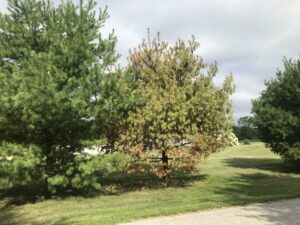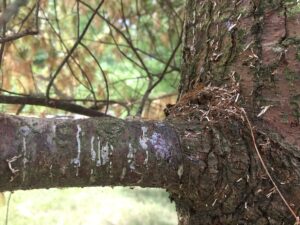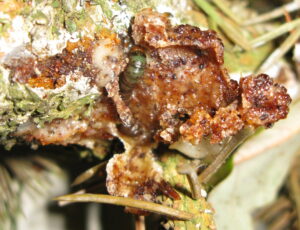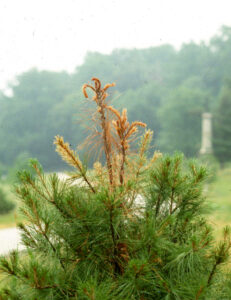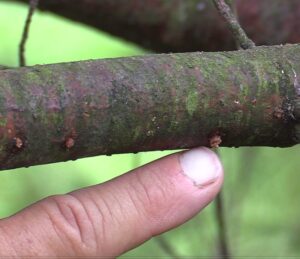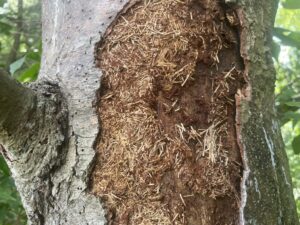Trees stressed by prolonged drought are more subject to attack by boring insects. This article provides tips and a video link on how to manage pines for borers.
Record breaking heat and sporadic rainfall during July of 2023 took their toll on landscape trees. Cone bearing evergreens, like white pines, are especially susceptible to drought and flooding. These environmental stresses reduce the ability of trees to defend themselves against boring insects. To make matters even worse, insect borers use their keen sense of smell to guide them to these stressed trees. Trees often take several years to recover from drought. Monitoring trees for early signs of decline is critical to a successful management program.
Early intervention can help you keep infested trees from becoming a breeding ground for borers that can destroy an entire planting. Trees that are more than half dead, or those whose needles are mostly yellow are usually too damaged to save. Removing these trees in late fall and winter removes the reproducing borers from the landscape before borers they can emerge to attack healthy trees. As an extra protective measure, insecticides can be applied on to the trunk to kill boring insects chewing into or out of the trees. Apparently healthy trees located near borer-infested trees can also benefit from a soil applied insecticides, like imidacloprid or dinotefuran applied in fall and early spring.
- Figure 1. By the time all pine leaves are yellow, it is too late to save a tree.
- Figure 2. Fine powdery sawdust left by bark beetles and fine shavings of sawyer beetles are signs that a tree may already be too damaged to save.
- Figure 3. Zimmerman pine moth caterpillar in wound.
Zimmerman pine moth (ZPM)commonly attacks pine trees in late July. Adult female moths lay eggs at the junction of tree branches and the trunk and winters in cracks and crevices. In early spring, when forsythia bloom, larvae bore inside the trunk and can girdle and kill branches and trees leaders. These are the two times of year that this borer is most susceptible to insecticides. Note soil applied imidacloprid is not particularly effective against ZPM. Spruces and most pines are susceptible to this borer.
- Figure 4. White-pine leader attacked by weevil.
White pine weevils attack the central leader of the pines, when forsythia bloom in early spring and Norway spruce in and will emerge from shoots in late July. When practical, pruning out the infested shoots before adults have emerged from shoots. Early spring application of long lasting insecticides, or soil applications of imidacloprid can also reduce problems with this pest.
- Figure 5. Holes and pitch tubes of pine engraver beetle.
Several species of bark beetles attack pines in Indiana. They actively fly in April and May to attack trees. Adults mate on the trees in the spring and lay eggs in channels beneath the bark. Eggs hatch from egg laying chambers and make distinctive patterns before emerging as adults in mid-summer and again in September.
- Figure 6. Bark of heavily infested pine trees can come off in sheets.
By the time pine sawyer beetles attack pine trees, they often have already been attacked by bark beetles and may even have been infested with the nematodes that cause pine wilt disease. Tree removal is the best option for control on these trees.
For more details on how to detect and manage borers, please view this short video in English Beating Back Borers on Pines and other Cone Bearing Evergreens, or Spanish Manejo de Barrenadores de Pino and consult the Purdue Plant Doctor web page.
Additional Resources:
Borers of pines and other needle bearing evergreens in the landscape
